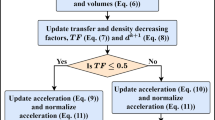Abstract
This paper proposes an adaptive neural network (ANN) model for modeling the nonlinear dynamic of a robot manipulator based on experimental input–output data from the system. The ANN model is created by combining the multilayer perceptron neural network structure and the nonlinear auto-regressive with eXogenous input model and is trained by the modified differential evolution (MDE) algorithm. The effectiveness of the proposed method is evaluated and compared with other algorithms such as the back-propagation algorithm, the traditional differential evolution and the hybrid differential evolution–back-propagation algorithm. The results prove that the proposed ANN model optimized by the MDE algorithm for the 5-DOF robot manipulator dynamic is successfully modeled and performed well.







Similar content being viewed by others
References
Anh HPH, Ahn KK (2013) A new approach of the 2-axes pam robot arm identification using neural mimo narx model. Int J Artif Intel Tools 22(01):1–26
Basso M, Giarre L, Groppi S, Zappa G (2005) Narx models of an industrial power plant gas turbine. Control Syst Technol IEEE Trans 13(4):599–604
Brest J, Bošković B, Greiner S, Žumer V, Maučec MS (2007) Performance comparison of self-adaptive and adaptive differential evolution algorithms. Soft Comput 11(7):617–629
Chauhan N, Ravi V, Chandra DK (2009) Differential evolution trained wavelet neural networks: application to bankruptcy prediction in banks. Expert Syst Appl 36(4):7659–7665
Das S, Abraham A, Chakraborty UK, Konar A (2009) Differential evolution using a neighborhood-based mutation operator. Evolut Comput IEEE Trans 13(3):526–553
Das H, Jena AK, Nayak J, Naik B, Behera H (2015) A novel pso based back propagation learning-mlp (pso-bp-mlp) for classification. Computational intelligence in data mining, vol 2. Springer, Berlin, pp 461–471
Dash CSK, Dehuri S, Cho S-B, Wang G-N (2015) Towards crafting a smooth and accurate functional link artificial neural networks based on differential evolution and feature selection for noisy database. Int J Comput Intel Syst 8(3):539–552
Diaconescu E (2008) The use of narx neural networks to predict chaotic time series. Wseas Trans Comput Res 3(3):182–191
Gämperle R, Müller SD, Koumoutsakos P (2002) A parameter study for differential evolution. Adv Intel Syst Fuzzy Syst Evol Comput 10:293–298
Gaspar CRM, Velázquez-Velázquez JE, Rodríguez JCT, (2015) Identification of a cylindrical robot using recurrent neural networks. Multibody mechatronic systems, pp 381–389. Springer, Berlin
Gori M, Tesi A (1992) On the problem of local minima in backpropagation. IEEE Trans Pattern Anal Mach Intel 1:76–86
Hovland G, Berglund E, Hanssen S, AB AR (2001) Identification of coupled elastic dynamics using inverse eigenvalue theory. In: International symposium on robotics, vol 19, p 21
Huang H-X, Li J-C, Xiao C-L (2015) A proposed iteration optimization approach integrating backpropagation neural network with genetic algorithm. Exp Syst Appl 42(1):146–155
Hung Y-C, Lin F-J, Hwang J-C, Chang J-K, Ruan K-C (2015) Wavelet fuzzy neural network with asymmetric membership function controller for electric power steering system via improved differential evolution. Power Electr IEEE Trans 30(4):2350–2362
Ilonen J, Kamarainen J-K, Lampinen J (2003) Differential evolution training algorithm for feed-forward neural networks. Neural Process Lett 17(1):93–105
Karaboga N, Cetinkaya B, (2005) Performance comparison of genetic and differential evolution algorithms for digital fir filter design. Advances in information systems, pp 482–488. Springer, Berlin
Kuschewski JG, Hui S et al (1993) Application of feedforward neural networks to dynamical system identification and control. Control Syst Technol IEEE Trans 1(1):37–49
Liu J, Lampinen J (2005) A fuzzy adaptive differential evolution algorithm. Soft Comput 9(6):448–462
Narendra KS, Parthasarathy K (1990) Identification and control of dynamical systems using neural networks. Neural Netw IEEE Trans 1(1):4–27
Östring M, Gunnarsson S, Norrlöf M (2003) Closed-loop identification of an industrial robot containing flexibilities. Control Eng Pract 11(3):291–300
Pham MT, Gautier M, Poignet P (2001) Identification of joint stiffness with bandpass filtering. In: Robotics and automation, IEEE international conference on, vol 3, IEEE (2001), pp 2867–2872
Piotrowski AP (2014) Differential evolution algorithms applied to neural network training suffer from stagnation. Appl Soft Comput 21:382–406
Piroddi L, Spinelli W (2003) An identification algorithm for polynomial narx models based on simulation error minimization. Int J Control 76(17):1767–1781
Qin AK, Huang VL, Suganthan PN (2009) Differential evolution algorithm with strategy adaptation for global numerical optimization. Evol Comput IEEE Trans 13(2):398–417
Ronkkonen J, Kukkonen S, Price KV (2005) Real-parameter optimization with differential evolution. Proc IEEE CEC 1:506–513
Sarangi PP, Sahu A, Panda M (2013) A hybrid differential evolution and back-propagation algorithm for feedforward neural network training. Int J Comput Appl 84(14):1–9
Son NN, Anh HPH (2015) Adaptive displacement online control of shape memory alloys actuator based on neural networks and hybrid differential evolution algorithm. Neurocomputing 166:464–474
Storn R, Price K (1997) Differential evolution-a simple and efficient heuristic for global optimization over continuous spaces. J Glob Optim 11(4):341–359
Subudhi B, Jena D (2011) A differential evolution based neural network approach to nonlinear system identification. Appl Soft Comput 11(1):861–871
Subudhi B, Jena D (2011) Nonlinear system identification using memetic differential evolution trained neural networks. Neurocomputing 74(10):1696–1709
Swevers J, Verdonck W, Schutter JD (2007) Dynamic model identification for industrial robots. Control Syst IEEE 27(5):58–71
Vesterstrøm J, Thomsen R (2004) A comparative study of differential evolution, particle swarm optimization, and evolutionary algorithms on numerical benchmark problems. In: Evolutionary computation, congress on, vol 2, IEEE, pp 1980–1987
Wang X, Tang Z, Tamura H, Ishii M, Sun W (2004) An improved backpropagation algorithm to avoid the local minima problem. Neurocomputing 56:455–460
Wang Y, Cai Z, Zhang Q (2011) Differential evolution with composite trial vector generation strategies and control parameters. Evol Comput IEEE Trans 15(1):55–66
Acknowledgments
This paper was completely supported by the National Foundation for Science and Technology Development (NAFOSTED), under Grant Number 107.01-2015.23, Viet Nam and the DCSELAB, VNU-HCM, Viet Nam.
Author information
Authors and Affiliations
Corresponding author
Ethics declarations
Conflict of interest
The authors declare that they have no conflict of interest.
Additional information
Communicated by V. Loia.
Rights and permissions
About this article
Cite this article
Son, N.N., Anh, H.P.H. & Chau, T.D. Adaptive neural model optimized by modified differential evolution for identifying 5-DOF robot manipulator dynamic system. Soft Comput 22, 979–988 (2018). https://doi.org/10.1007/s00500-016-2401-x
Published:
Issue Date:
DOI: https://doi.org/10.1007/s00500-016-2401-x




